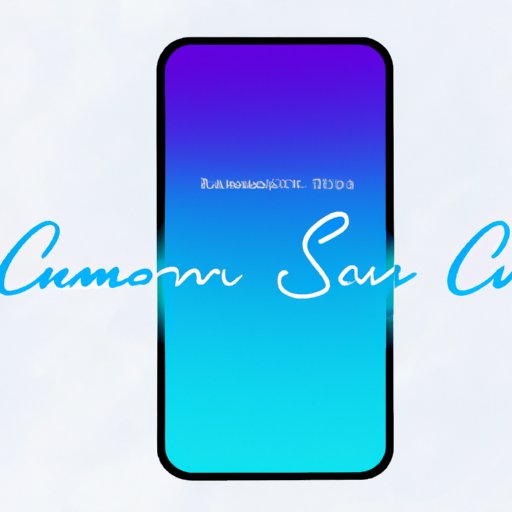
I. Introduction
A lock screen is the first thing you see when you pick up your phone. It’s a protective layer that secures your device while showcasing important information like battery life, time, date, and notifications. Customizing your lock screen not only adds flair to your device but also enhances the functionality of the lock screen.
With the advancements in technology, customizing your lock screen is becoming more accessible and intuitive. In this article, we’ll discuss different ways to customize your lock screen ranging from personalizing your wallpaper and adding widgets to control center customization and personalized messages.
II. Personalizing the Wallpaper
The wallpaper is an excellent way to spice up your lock screen and showcase your personality. Here’s how you can change the wallpaper on your lock screen:
- Go to “Settings” on your phone.
- Click on “Wallpaper.”
- Select your desired image.
- Click on “Set Lock Screen.”
While choosing a wallpaper, consider the colors and patterns you enjoy. You can choose a photo or a background from a wallpaper app. Ensure that the image size is appropriate to fit your lock screen without being stretched or pixelated.
III. Add Widgets
Widgets are a great way to interact with your lock screen and get quick information like weather updates, news, notes, or calendar entries. Here’s how you can add widgets to your lock screen:
- Swipe right from your lock screen and tap on “Edit.”
- Click on the green “+” icon next to the widget you want to add.
There are different types of widgets available, such as information, media, and control widgets. You can add widgets that represent your most frequent tasks. Adding widgets saves you time and effort and gives you the latest information without unlocking your device.
IV. Add Shortcuts
Shortcuts provide easy access to your frequently used apps. Here’s how you can add shortcuts to your lock screen:
- Go to “Settings” on your phone.
- Click on “Apps & Notifications.”
- Select the App you want to add a shortcut for.
- Tap on “Add to Home screen.”
Some useful shortcuts to add can be camera, messaging, calculator, or your favorite social media app. Customizing shortcuts based on your personal preferences saves time and gives you access to the most important features without undue hassle.
V. Change Notification Settings
The notification settings directly affect how your lock screen functions and how you interact with your phone. Here’s how to modify your notification settings:
- Go to “Settings” on your phone.
- Click on “Apps & Notifications.”
- Select the App you want to change notification settings for.
- Tap on “App Notifications.”
You can change the notifications based on what you find important. For example, you can choose to display “Silent notifications,” stop notifications altogether, or mute certain apps during specified times. Changing the notification settings helps keep you organized and gives you easy access to the essential notifications.
VI. Control Center
The iPhone’s control center can be customized to meet your unique needs. Here’s how to customize your control center:
- Go to “Settings” on your phone.
- Click on “Control Center.”
- Select “Customize Controls.”
- Add or remove controls, reorder them, or group them into one.
You can customize your control center based on what control you use the most. If you text a lot, adding the messaging app to your control center can save you a lot of time. Sample use cases include adding a sound recorder, the calculator, a flashlight, or a camera app. Adding or removing the controls allows you to optimize your user experience.
VII. Add Personalized Messages
Personalized messages on the lock screen can be used to set reminders or motivational quotes. Here’s how you can add personalized messages:
- Go to “Settings” on your phone.
- Click on “Lock Screen.”
- Tap on “Screen message.”
- Type in your desired message.
You can add your favorite quotes, reminder messages, or to-do lists, which can act as an encouragement to start the day on a positive note.
VIII. Choose Third-Party Apps
Third-party apps can help you customize your lock screen further. Here are some apps to consider:
1. Widget Smith: Helps you create customized widget layouts with the ability to add your own photos.
2. Noted: Lets you jot down notes on your lock screen, making it simple to keep track of essential information.
3. Quickie: Allows you to add shortcuts for your contacts, making it simple to connect further.
These apps can do wonders in terms of personalizing your lock screen, so do some research and find the one that meets your needs.
IX. Conclusion
Customizing your lock screen showcases your individuality and makes it easy to access your most important apps and messaging features. There are various ways to customize your lock screen to suit individual preferences ranging from personalizing your wallpaper and adding widgets to control center customization and personalized messages.
With these customization options, you can make your phone an extension of yourself and increase accessibility to the apps that matter most.





